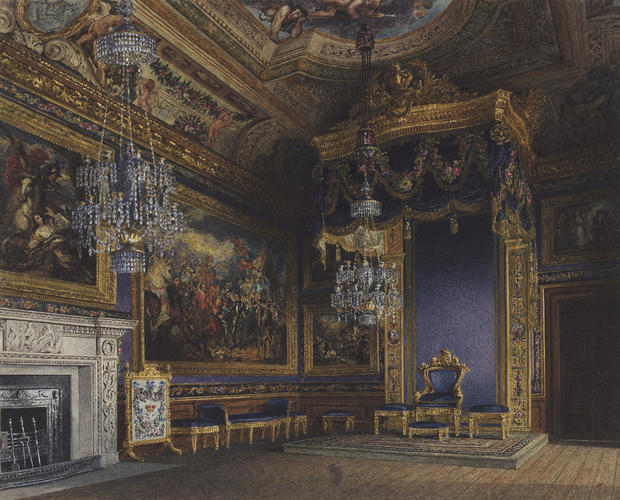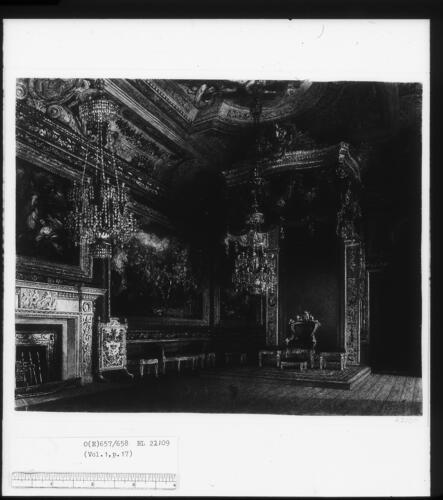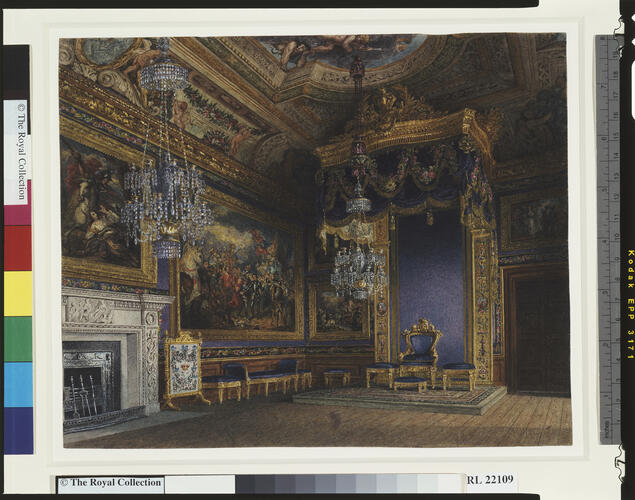Charles Wild (1781-1835)
Windsor Castle: The King’s Audience Chamber c. 1818
Pencil, watercolour and bodycolour | 20.6 x 25.2 cm (sheet of paper) | RCIN 922109
-
A watercolour view of the King's Audience Chamber before Wyatville's remodelling of 1820s, featuring mauve walls and throne canopy. Verrio's ceiling depicts the re-establishment of the Church of England in 1660. A neo-classical chimney piece is on the left, along with blue/mauve covered stools and chairs. Large paintings hang on the walls. Prepared for one of the plates in William Henry Pyne's History of the Royal Residences (1816-1819). Engraved by T. Sutherland, the print published 1.2.1818. It is now known as the Garter Throne Room.
Pyne's History of the Royal Residences was a three-volume publication which encompassed a number of royal residences, including Windsor Castle (vol. 1) and Buckingham House (vol. 2), presenting 100 hand-coloured engravings of exteriors and interiors accompanied by descriptive texts. The 100 watercolours which were engraved for the publication survive in the Royal Library; these watercolours are exactly the size of the image on the printed plates, and may perhaps have been intended as colour guides for the artists responsible for hand-painting the monochrome prints.
Catalogue entry adapted from George III & Queen Charlotte: Patronage, Collecting and Court Taste (London, 2004)
The King’s Apartments at Windsor, which date from the reign of Charles II, all overlook the North Terrace. The Audience Chamber was the third of the sequence of King’s Rooms; in the 1830s it was remodelled by Wyatville as the Ante-Throne Room. From the late 1770s George III began to refurbish these rooms, with the assistance of his architect William Chambers. The resulting changes are recorded in the plates of Pyne’s Royal Residences for the Audience Chamber, the Drawing Room, the Bedchamber, the Dressing Room, and the Closet.
The Audience Room received particularly lavish attention at this time. According to Pyne, the changes were carried out ‘under the direction of his Majesty . . . with great elegance’. Although many of the seventeenth-century elements were retained - including Verrio’s fine ceiling painting, and the richly carved cornice - up-to-date colours, finishes and furnishings were introduced. The walls were relined with Garter blue flower-bordered silk, and a new marble chimneypiece was introduced in 1786. George III’s veneration of the Order of the Garter, seen throughout his work at Windsor, was reflected in the series of paintings executed by Benjamin West for this room in 1787-9. They record the exploits of Edward III and the Black Prince, culminating in the foundation of the Order in 1348. The West paintings visible in this image are, over the mantle, St George and the Dragon (406165) and to its right, Edward III and the Black Prince after the Battle of Crecy (407523). To the left of the throne a barely visible painting, Edward III entertaining his Prisoners (404925), hangs over The Crossing of the Somme (404566); the overdoor to the right is the Burghers of Calais (404927). A schematic view of the room (924429) tells us that the Battle of Poitiers (407522) hung to the left of the mantle; the Institution of the Order of the Garter (407521) on the wall opposite the thone, and Queen Philippa at Neville’s Cross (404926) was the other overdoor.
A striking element of this view is the throne canopy ‘and its appendages’: according to Pyne, Robert Campbell was responsible for the splendid new throne, the canopy was produced by Mrs Pawsey to designs by Mary Moser, and the pilasters were painted by Biagio Rebecca under the direction of Benjamin West. In the almost complete absence of bills for furnishings at this period, Pyne’s illustration, together with his summary of the designers and craftsmen involved at Windsor in the 1780s, has led to the attribution of several pieces of furniture in the Collection. Pyne’s canopy, but not its hangings, cresting and back-cloth, may have survived in the Garter Throne Room.Provenance
Probably acquired by George IV
-
Creator(s)
Acquirer(s)
-
Medium and techniques
Pencil, watercolour and bodycolour
Measurements
20.6 x 25.2 cm (sheet of paper)
Other number(s)
RL 22109Alternative title(s)
King's Audience Chamber, Windsor Castle.










